- 47929A Fremont Blvd. Fremont CA 94538
- (510) 413-9055
The recently shared allocation model aligns with our expectations and planning efforts. Any staff pulled from other sites will be carefully analyzed and monitored to ensure no impact.
We have developed a comprehensive strategy focused on scaling operations and expanding our workforce and resources to accommodate the increased workload from newly visible projects. Early last year, we anticipated significant growth with Meta and our other hyperscale customers. In response, we have prioritized investing in our people by identifying high-performing individuals and accelerating their development to prepare them for more challenging roles. This succession planning initiative has created a robust talent pipeline, ensuring a strong bench of ready candidates for critical positions.
Additionally, we plan to double our direct labor force to meet the growing demand. To support this expansion, we are collaborating with Direct Line University (DLU) to implement a hands-on, four-week “bootcamp” training program. This program is designed to equip employees with the necessary skills and knowledge before they arrive at project sites. Completing the program is mandatory, ensuring all technicians meet our high standards of readiness and capability. The bootcamp also serves as an opportunity to identify and nurture top talent, offering additional guidance to those needing it. This ensures our workforce is fully prepared to execute at the highest level and meet the challenges ahead.
Direct Line has expanded its Resource Solutions Group (RSG) to bolster our recruiting efforts and strengthen our presence in these new markets. By increasing the size and capacity of RSG, we aim to enhance our ability to identify and attract top talent, ensuring that we effectively meet the growing demands of these markets. This expansion reflects our commitment to investing in strategic growth and delivering exceptional recruitment solutions tailored to the unique needs of these regions.
Finally, Direct Line has taken steps to vet some subcontractors, which can also be used to source a mobile labor force.
It is important to understand that Direct Line’s methodology has always been to seed the new sites with key roles and expertise and groom new talent to support the additional sites. This approach allows Direct Line to scale its delivery capacity significantly without impacting its current operations. The industry is growing significantly, and moving resources from site to site will not achieve the desired scale.
For this market, it is also important to understand that the majority of the resource pool will not be seeded locally. This allows us to recruit from other talent-rich markets, including our agency bench, and travel them in or develop some subcontractors that we can leverage for resource ramps.
Additionally, Direct Line has refined our quality program with institutionalized standards, which have been integrated into our sites, and through training our employees in the Direct Line Way.
Current operations are well-positioned from a labor and management perspective. They are running independently without much oversight from a programmatic perspective, so utilizing some of the talent from these sites will not impact them.
We have identified several risks in this project. Labor shortages, limited housing, supply chain constraints, and the large ramp in our direct labor staff. The increase in staff was forecasted over a year ago, and we have been planning around this since then. We have been developing our bootcamp program and our succession program to help mitigate this risk. The shortage of local talent is the reason why there is a push for the 70% travel component. Regarding limited housing, there hasn’t been a clear direction on housing these resources.
Direct Line will staff this project with minimal disruption to existing projects. While our approach involves placing leadership from various sites, we will not reassign resources if it risks current project milestones. We intend to draw from locations that can continue to succeed without impact. A thorough review is underway to identify potential sites with available resources to support this program. Beginning in early 2025, we plan to recruit and staff additional management at each location to either backfill existing site roles or train team members prepared to relocate to Holly Ridge, LA.
Dustin Powell, a tenured Direct Line SME, will be a point on the project and will work closely with the back office team to understand the project requirements and ensure it is staffed appropriately. Dustin will be working closely with Adam Madison (build sequencing, scheduling) and Sam Slingerland (Safety) to ensure we have the proper visibility of the project and the capability to collaborate with the extended GC/TC/Meta teams. Dustin and Adam’s extended teams will also be shadowing the site team during project execution to ensure that all requirements are being met.
Once we receive the official award notice, we will fill in the fields with actual names. We plan to hire staff six months in advance and provide training at our other locations, ensuring they are well-prepared before the project begins at Holly Ridge, LA.
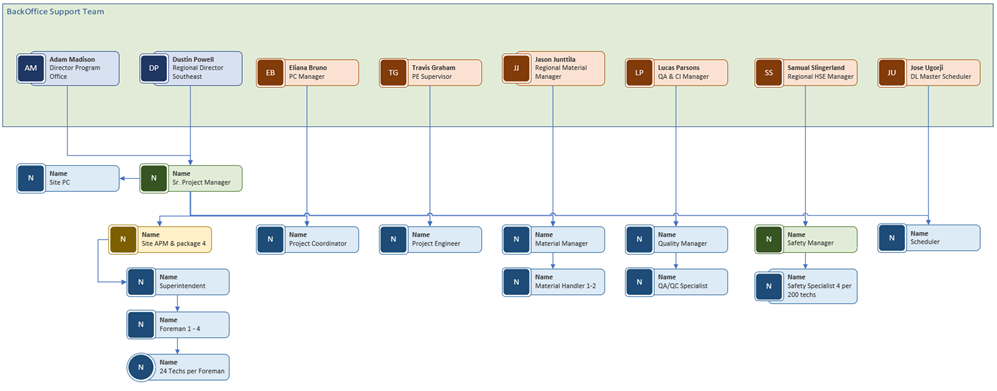
Direct Line expects all leadership roles to be filled by existing resources or resources whom we are proactively hiring in advance for OJT. We expect the PM, PE, Super, and P6 to be hired and onboarded within the next three months for placement at one of our existing project sites or to replace those roles at existing sites once 10x kicks off. We will also be incentivizing Foremen, Leads, and Quality to relocate. Roles such as Safety and PC can be filled locally.
While technicians in this market can be drawn from the region, a majority of the resources will need to travel. We will be canvassing the market for apprentice/installer-level roles for which we can train. Technician/Lead roles will need to be traveled in.
Surrounding markets such as Jackson, MS, and Huntsville, AL, will play a vital role in recruitment, as we are currently in those markets. We will work to build the Monroe, LA market as part of this. The University of Louisiana would be a source of talent.
Based on this structure, Direct Line expects all management roles (100%), including foremen and leads, to be sourced from within Direct Line ranks. The technician pool will be recruited from volunteers from other sites (10%), recruited from our agency bench (30%), and subcontracted (30%).
Direct Line has a good working relationship with both GCs, and we are well-positioned to participate in both package 4 scopes. The Direct Line mobilization plan assumes both packages. This assures success if one or both packages are awarded.
This could change depending on which package we receive or a combination; however, this is the one we suggest.
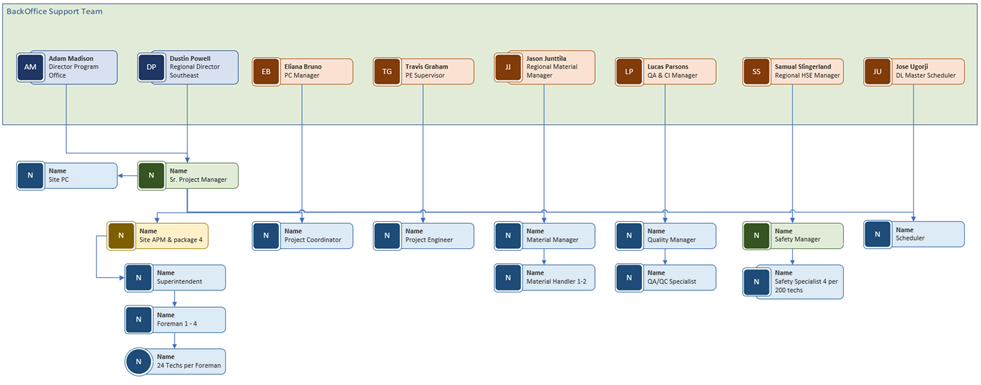
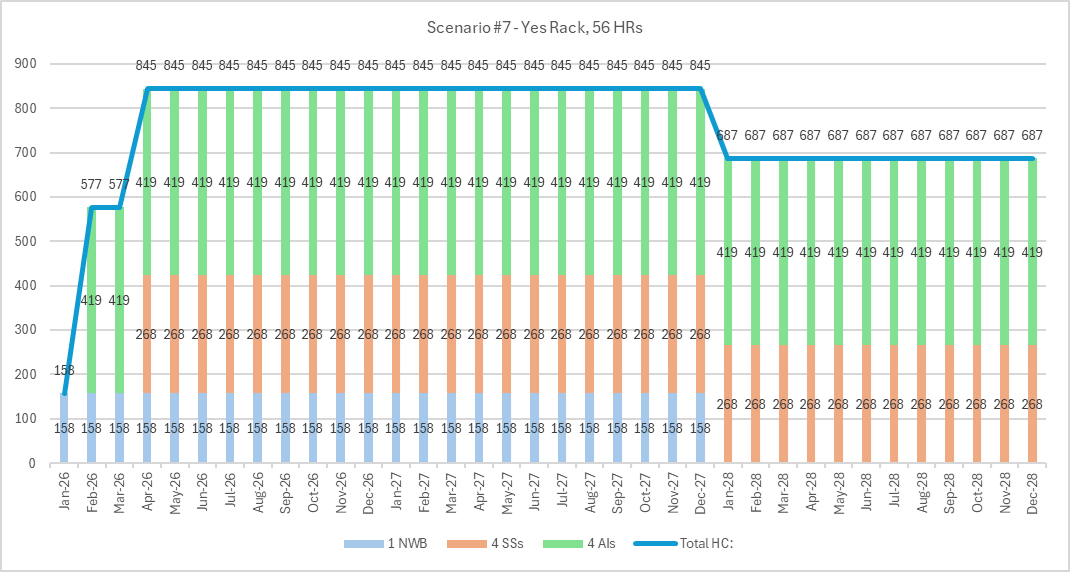

Direct Line’s approach to corporate governance is comprehensive and multi-tiered, ensuring robust oversight across each project with Meta. Monthly performance reviews are conducted at the corporate level, while account and operational levels hold weekly assessments. These frequent evaluations cover critical areas, including safety, quality, financial performance, staffing levels, resource management, risk assessment, and schedule adherence (e.g., Milestone and Production Ready dates).
This rigorous oversight framework ensures that project teams fully align with Direct Line’s procedures, removing any roadblocks that may hinder progress. By strictly adhering to established processes, Direct Line meets and often exceeds client expectations regarding cost, quality, and schedule. Additionally, this standardized oversight enables consistent, high-quality service delivery across all Meta Fleet locations where Direct Line operates.
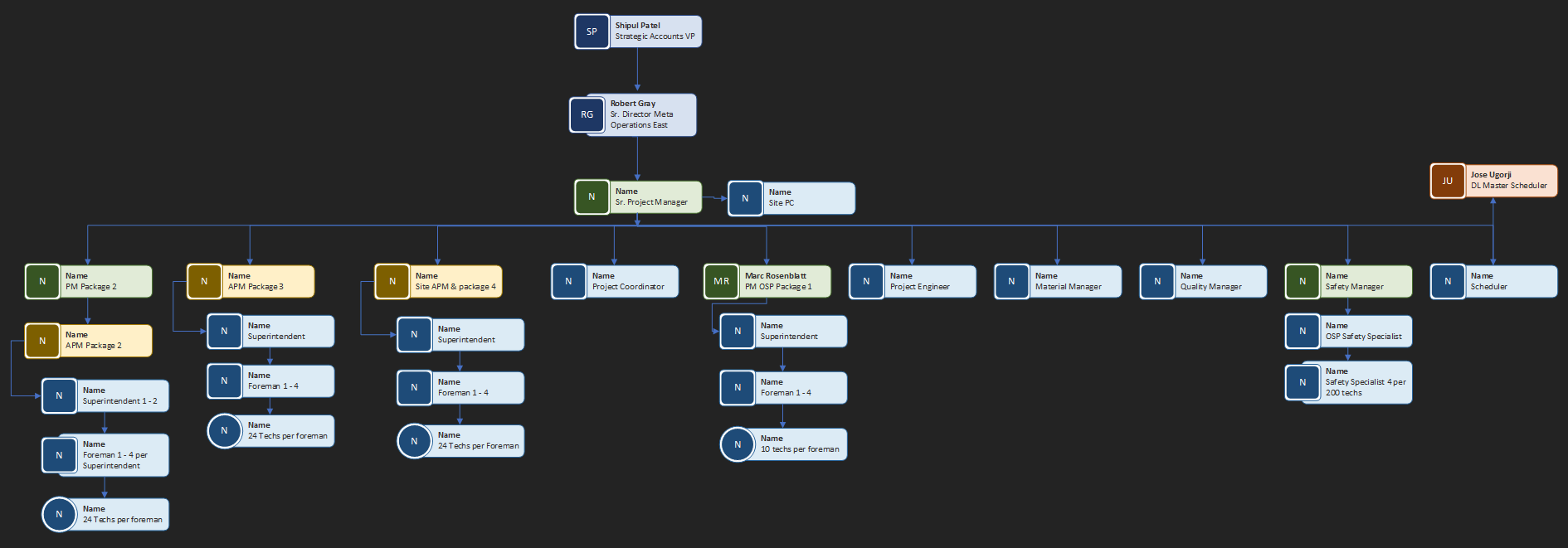
Direct Line’s approach to the 10X staffing model maintains a traditional top-down project structure while allowing flexibility in staffing plans organized by work package. Governance within the organization remains consistent, with oversight from the VP of Strategic Accounts and the Director of Operations. Due to the scale of the 10X initiative, a Senior Project Manager will lead the campus project team, supported by a 12-member staff as detailed in the organizational chart.
This staffing approach ensures that each package is managed effectively according to its specific needs, with appropriate staffing levels aligned to the scope of work. This approach enables quick adjustments to the project team as work packages are assigned, allowing for flexibility in staffing based on each package’s specific needs and scope.
Project Leadership Staffing Approach
Direct Line’s leadership staffing strategy for new greenfield projects involves deploying a team entirely composed of experienced resources from active projects within our organization, with no more than 20% drawn from any single site. This approach promotes efficient knowledge transfer and minimizes onboarding and ramp-up times. Thanks to our internal leadership succession and training program, we can seamlessly replace any position shifted to a new project, ensuring continuity across sites.
Direct Labor Staffing approach:
This geographic region will likely have limited subcontractors and vendors experienced in this scope of work. In response, Direct Line has established strategic partnerships with multiple U.S.-based and international resource providers. These partners offer training programs that enable Direct Line to staff teams with foundational skills in telecom installation, following the industry-recognized BICSI standard.
Additionally, Direct Line has developed an in-house training division, Direct Line University (DLU), which uses BICSI standards to teach Meta-specific installation and quality practices. This approach enables us to achieve a higher quality pass rate, minimizing rework that could affect project schedules. We will also rely on DLU’s capabilities and proven track record to develop local talent or refresh incoming talent.
The rapid growth of the data center industry has created a high demand for skilled construction resources, leading to labor shortages in many regions. Skilled workers, such as electricians, HVAC specialists, project managers, and even technicians, are in high demand but short supply. This shortage is compounded by the complexity and scale of data center projects, which require specialized expertise and strict adherence to safety and quality standards. Recognizing this, Direct Line has invested in training programs, partnerships with trade schools, and innovative workforce development strategies to address these gaps and ensure projects are staffed appropriately.
Direct Line’s core strategy is to deploy experienced leadership from established sites to new project regions, ensuring essential knowledge transfer. This approach allows most field technicians to be sourced locally or, in challenging areas, brought in from other locations as needed.
Our commitment to employee support and development is a key part of our strategy and values. We aim to provide each team member with a clear career path and a development plan tailored to their goals. Central to this vision is our robust succession plan, which ensures seamless transitions in critical roles due to retirements, promotions, relocations, or other changes. Key components of our succession strategy include:
This structured approach ensures that Direct Line is continually equipped with skilled leaders ready to advance into critical roles, securing continuity and supporting our long-term success.
While Direct Line has a healthy current backlog, we can execute without disrupting any of our projects.
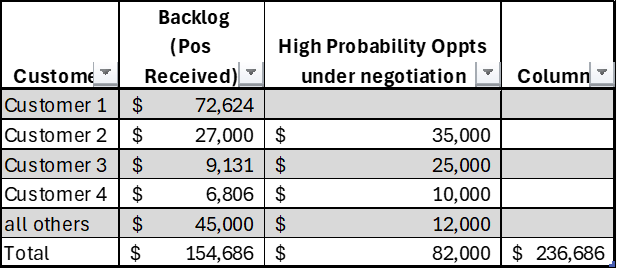
We are partnered with the CWA union.
No, we work with other trades that have open shops at all our sites.
All new hires receive at least one week of training and are partnered with experienced techs for 90 days. Direct Line has additionally been putting together a month-long boot camp as another avenue for training, especially if the local resources are sourced from a very different industry. We do not identify new hires with different PPE.
Direct Line realizes that the housing infrastructure in Holly Ridge, LA, is inadequate to sustain the proposed workforce. We do not have an issue with craft housing.
Direct Line anticipates a higher-than-usual attrition rate and is currently projecting approximately 15-20% attrition. While we will create incentive packages to reduce this, working away from home for 4 years will impact the workforce.
Yes, we intend to seed the site with experienced FTEs and new hires. As mentioned, Direct Line expects all management roles (100%), including foremen and leads, to be sourced from within Direct Line ranks. The technician pool will be recruited from volunteers from other sites (10%), recruited from our agency bench (30%), and subcontracted (30%).
From our perspective, the 2,500 technicians referenced accounted for the entire project based on a standard 40-hour workweek. We estimate a headcount of approximately 400 technicians for the AI package alone, assuming a 56-hour workweek.
Our union compensation aligns with the mean averages of the oil and gas industry. Additionally, we feel the environment will be more attractive than in the oil and gas industry.
Yes, we are planning a mix of current Direct Line employees and new hires.
We expect that all management positions will be filled by an existing Direct Line employee or an employee hired and placed at one of the project sites for 6-9 months for OJT. We have not communicated broadly to the extended team regarding relocation, etc. Once we receive the official notice of award, we will fill in the various fields with actual names.
The expectation is that management will relocate to Holly Ridge, LA, so there will be adequate management coverage. The direct labor will be rotated by teams. Our suggestion is to have the field team work for 21 days continuously and then receive a rotation home for 10 days.
Given the project’s scale and Holly Ridge’s limited local workforce, it’s reasonable to anticipate that a significant portion of the workforce will need to travel from other regions. Direct Line estimates 70% of the workforce will require travel and accommodation. Since the final scope and associated headcount are not defined, we have proposed a sample cost structure for a single traveler.
This analysis includes all travel, accommodation, and car rental costs for a single traveler commuting from California to Holly Ridge, LA, on a rotational schedule. The traveler flies home every 21 days, takes a 10-day break, and returns, requiring comprehensive travel, lodging, and transportation provisions. This cycle allows the traveler to maximize their time onsite, receiving overtime pay as an incentive and an extended break as a further incentive.
Total Annual Travel, Accommodation, and Car Rental Cost per Traveler: $73,810
It is important to recognize that these costs could be drastically reduced if a housing solution, onsite meals, shuttle services, and negotiated airfare were used for the full team onsite.
The fee and markup structure is similar to our Type-F project in LCO. We will have to recognize that the travel structure will be different, but we can work with Meta to define an appropriate structure.
Direct Line recognizes that relocation will be more cost-effective than traveling, and we will offer relocation to anyone willing to move to the region. The package will vary based on whether it is a management role or a field role. Per diem and airfare are assumed for all traveled positions. Rental cars will be limited to certain positions. Direct Line is currently exploring shuttle services for our field employees, or is willing to use any
GC-provided shuttles to reduce that cost.
The field already receives time and a half or double time based on hours worked. This suggestion was to incentivize the non-salary management on-site.
Labor is provided through our staffing agencies to address temporary peaks in requirements.
All internal Direct Line incentives (bonuses and salary adjustments) would be overhead; any additional pay for incentive/relocation/travel would be a work cost.
Direct Line has adopted the standard terms from our existing MCA and used them most recently on our LCO project. This should serve as a starting point since other terms will likely need to be included.
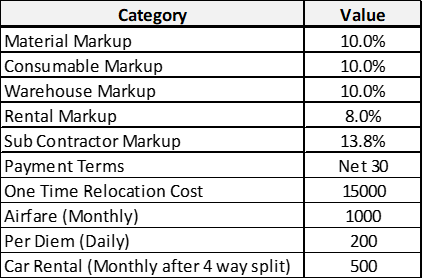
The bill rates for labor, locked for four years starting in 2026, are listed below. We assumed a 3% annual acceleration for all rates and used the average for the four years in the table below. Additionally, we used the same contractual billing methodology and allowances for burden and overhead. Flexibility will be needed with these rates as we look to attract talent to the market.
Recommendation:
Overtime for Management: Given the project’s criticality, a lever to use is potentially allowing overtime for management to incentivize them to take on the role.
Subsidized Salary for Technicians: Add a fixed number to the hourly salaries of each traveler as an incentive.
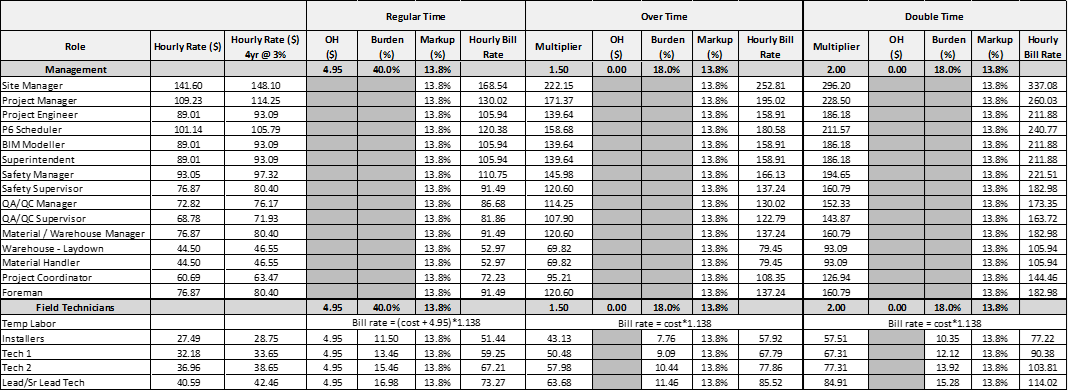
We are aware of and planning around this schedule.
We collaborate closely with the GC to understand their schedule and address any issues. Our scheduling is designed to complement the GC’s timeline. In most cases, when working directly with the GC, Direct Line has coordinated with the GC and other trades to assess and manage risks. This includes developing and maintaining a comprehensive schedule that incorporates all trade milestones.
Yes, we have several full-time schedulers who use Primavera P6 daily. Based on the allocations given, we are currently recruiting additional schedulers.
Direct Line has assembled several models, including a second and third shift, depending on schedule constraints.
In a critical construction project, effective collaboration between multiple trades, such as GCs, electricians, and the TCs, is essential to meeting tight schedules, adhering to high standards, and achieving successful outcomes. Each trade brings specialized expertise and requirements, often with overlapping dependencies that demand careful coordination and mutual respect.
For instance, electricians may need to complete wiring work before drywall installation can proceed or while the TCs install a portion of the infrastructure. Clear communication between these teams is crucial to avoid rework and, more importantly, to maintain a “clean” environment for the sensitive equipment installed. Regular meetings—such as weekly on-site huddles and daily check-ins—help all trades align on the day’s tasks, anticipate potential issues, and adjust sequencing as needed.
Using shared project management tools and documentation, teams can track progress, flag delays, and update dependencies in real time. This transparency allows teams to manage changes in scope or unexpected issues collaboratively, ensuring each trade can work efficiently without compromising safety or quality standards.
Furthermore, fostering a culture of respect and shared ownership over the project’s success reinforces team commitment. Trades that understand the roles and challenges of their counterparts are more likely to offer support, adapt their schedules, and maintain flexibility to keep the project on track. This careful, collaborative approach enables the seamless integration of various trades’ contributions, ultimately delivering a cohesive, high-quality result on schedule.
CBRE I Direct Line Interface Management and Coordination Strategy
In complex projects like 10X. Our approach to managing and monitoring these interfaces is designed to ensure seamless coordination, minimize disruptions, and maintain project momentum. Our comprehensive strategy for managing and monitoring interfaces ensures that all activities across different buildings and multiple subcontractors are seamlessly integrated for all network installation activities with those managed by DPR Construction and Turner Construction, aligned with the specified commencement and completion dates.
We will establish a dedicated Interface Management Team responsible for overseeing all interactions between our scope of work and other on-site activities. The Direct Line team will:
We will develop a Comprehensive Interface Management Plan (IMP) at the project’s outset, as a roadmap for coordinating all interface activities. The IMP will include:
Ensuring technical compatibility across different scopes of work is essential:
Effective coordination starts with meticulous planning. To manage overlapping activities effectively, we will:
Open and transparent communication is key to successful interface management. Our strategies include:
We proactively manage risks associated with interfaces:
Maintaining quality across interfaces is a priority:
Safety is integral to all our operations:
Efficient resource management prevents bottlenecks:
To accelerate timelines without compromising quality, we focus on:
We continuously assess and enhance our interface management practices:
By fostering collaboration, maintaining open communication, and implementing rigorous management processes, we are confident in our ability to deliver a coordinated and successful project. Our proactive approach minimizes risks, ensures quality, and keeps the project on track, assuring you that we can effectively handle the complexities of this undertaking.
Previously identified items, such as craft housing and local labor sourcing strategies, will require a coordinated effort from Meta. Providing a cohesive strategy around these areas rather than a disparate strategy from each GC/TC will be important.
We know this will be directly with the GCs and have a good working relationship with Turner and DPR.
Based on known material items for package 4, there are no major CFCI items that are required. However, many consumable items are needed to complete the network scope:
Velcro: Given the overall duration of the project, there are no current concerns with supply capabilities; however, with numerous vendors working to acquire the same material for multiple scope packages, this could become a potential supply chain issue for quantities over 1000/order.
| Cookie | Duration | Description |
|---|---|---|
| cookielawinfo-checkbox-analytics | 11 months | This cookie is set by GDPR Cookie Consent plugin. The cookie is used to store the user consent for the cookies in the category "Analytics". |
| cookielawinfo-checkbox-functional | 11 months | The cookie is set by GDPR cookie consent to record the user consent for the cookies in the category "Functional". |
| cookielawinfo-checkbox-necessary | 11 months | This cookie is set by GDPR Cookie Consent plugin. The cookies is used to store the user consent for the cookies in the category "Necessary". |
| cookielawinfo-checkbox-others | 11 months | This cookie is set by GDPR Cookie Consent plugin. The cookie is used to store the user consent for the cookies in the category "Other. |
| cookielawinfo-checkbox-performance | 11 months | This cookie is set by GDPR Cookie Consent plugin. The cookie is used to store the user consent for the cookies in the category "Performance". |
| viewed_cookie_policy | 11 months | The cookie is set by the GDPR Cookie Consent plugin and is used to store whether or not user has consented to the use of cookies. It does not store any personal data. |